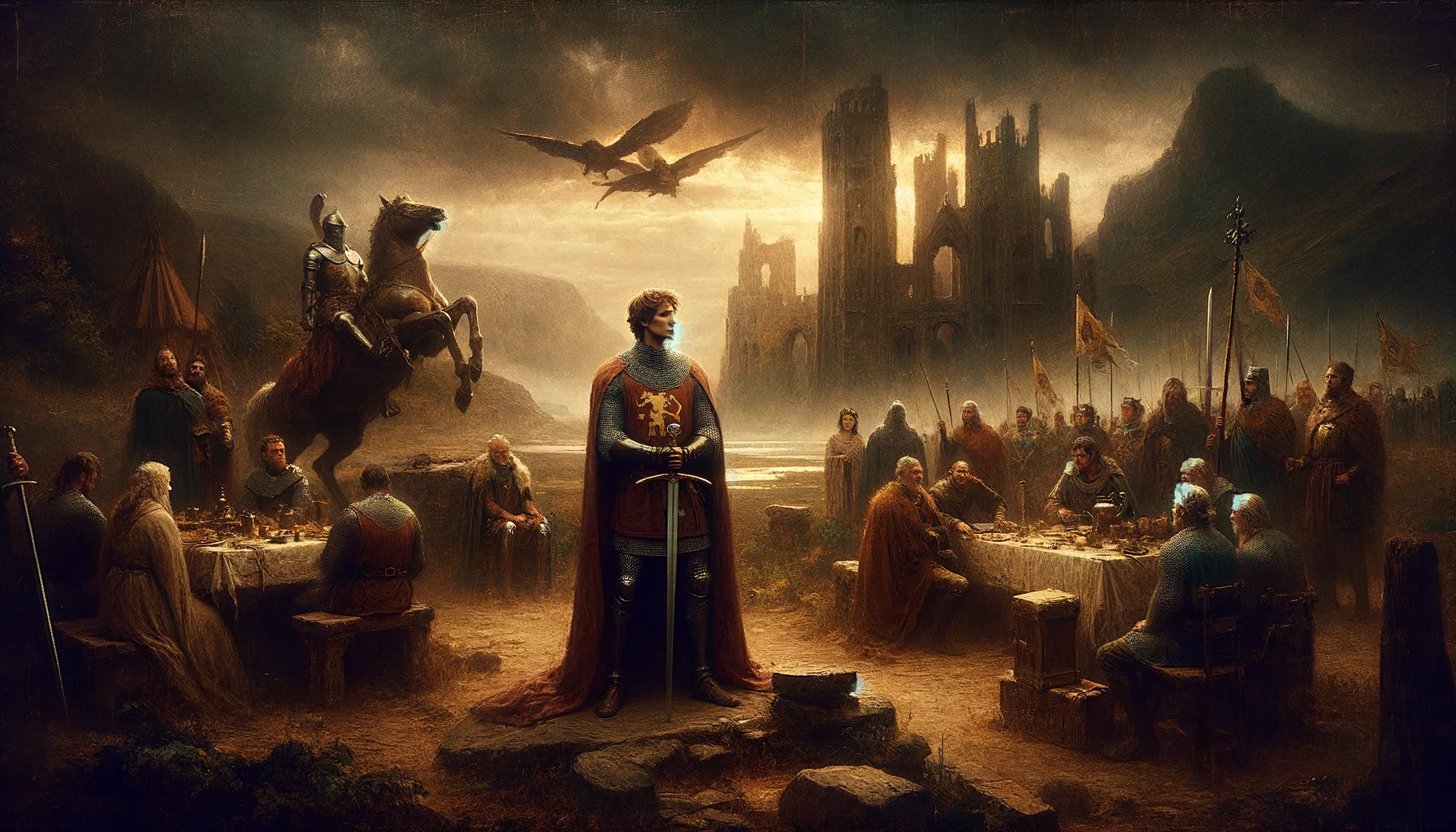Initial literary mentions of Arthur appear predominantly in Welsh and Breton narratives. Comprehensive analyses exploring Arthur’s depiction across the entire spectrum of pre-Galfridian tradition—beyond isolated texts or specific story genres—have been rare. There are three aspects to his character.
- Firstly, Arthur is depicted as an unparalleled combatant who served as Britain’s defender against various threats, both mundane, like his battles against the Saxons in the “Historia Brittonum,” and mystical, including encounters with giant cat-monsters, rampaging divine boars, dragons, dogheads, giants, and witches.
- Secondly, the version of Arthur before Geoffrey of Monmouth’s writings is seen as a legendary figure rooted in folklore (notably tied to geographical or naming folklore) and localized enchanting tales, where he leads a group of extraordinary heroes dwelling in nature’s untamed realms.
- Lastly, this early depiction of Arthur is intimately linked with the Welsh Otherworld, Annwn, portraying him as someone who attacks Otherworldly strongholds for treasure and liberates their captives. Moreover, his companions from the earliest tales include entities once considered deities in pagan beliefs, with his spouse and belongings distinctly emanating from the Otherworld.
Among the most celebrated references to Arthur within Welsh poetry is found in link_post [post_id=”13277″]Y Gododdin[/link_post] a compilation of heroic elegies attributed to the 6th-century bard Aneirin. One verse extolls the bravery of a warrior who vanquished 300 foes yet clarifies, “he was no Arthur” – indicating that, impressive as they were, his deeds did not match Arthur’s legendary valor. Although “Y Gododdin” survives in a manuscript from the 13th century, making it challenging to verify if the Arthurian mention is original or a subsequent addition, John Koch’s hypothesis suggesting a 7th-century origin for the passage remains speculative, with most scholars leaning towards a 9th- or 10th-century dating.
Furthermore, poems credited to Taliesin, reputed to be a contemporary of Aneirin, also feature Arthur, yet these works are generally believed to have been composed much later, between the 8th and 12th centuries. Among these are “Kadeir Teyrnon” (“The Chair of the Prince”), celebrating “Arthur the Blessed”; Preiddeu Annwn (The Spoils of Annwn), narrating Arthur’s journey into the Otherworld; and The Death-song of Uther Pendragon, which lauds Arthur’s bravery and hints at a paternal connection between Arthur and Uther, a concept predating Geoffrey of Monmouth’s accounts.
Among the earliest Arthurian texts from Welsh literature is the poem Pa gur Arthur and the Porter (“What man is the gatekeeper?”) found in the Black Book of Carmarthen. This piece unfolds as a dialogue between Arthur and a fortress’s gatekeeper, during which Arthur lists the names and achievements of his warriors, with Cei (Kay) and Bedwyr (Bedivere) receiving notable mention.
Another significant text, Culhwch and Olwen dated around 1100 and part of the contemporary Mabinogion anthology, expands Arthur’s retinue to over 200, again emphasizing Cei and Bedwyr’s prominence. The narrative centers on Arthur aiding his relative Culhwch in winning Olwen, Ysbaddaden Chief-Giant’s daughter, by undertaking a series of seemingly insurmountable tasks, one of which is hunting the quasi-divine boar Twrch Trwyth. This tale is also alluded to in the 9th-century “Historia Brittonum,” where the boar is named Troy(n)t.
Furthermore, Arthur features extensively in the Welsh Triads, brief compilations of Welsh traditions and legends grouped by threes for mnemonic purposes. Though later versions of the Triads draw from Geoffrey of Monmouth and continental sources, the oldest ones appear uninfluenced and reflective of pre-existing Welsh lore. In these early texts, Arthur’s realm symbolizes legendary Britain, with “Arthur’s Court” often synonymous with “The Island of Britain.” Despite the ambiguity of Arthur’s royal status in “Historia Brittonum” and the “Annales Cambriae,” by the era of “Culhwch and Olwen” and the Triads, he had ascended to “Penteyrnedd yr Ynys hon,” signifying his role as the paramount lord over Wales, Cornwall, and the North.
Beyond the pre-Galfridian Welsh poems and tales, Arthur is also featured in several early Latin texts aside from Nennius’ Historia Brittonum and the Annales Cambriae. Notably, Arthur is mentioned in various vitae (“Lives”) of post-Roman saints, though these are not generally deemed reliable as historical documents, with the earliest likely composed in the 11th century. For instance, in the early 12th-century “Life of Saint Gildas,” penned by Caradoc of Llancarfan, Arthur is accused of slaying Gildas’s brother, Hueil, and of rescuing his wife, Gwenhwyfar, from Glastonbury. In the “Life of Saint Cadoc,” authored around 1100 by Lifris of Llancarfan, the narrative details Saint Cadoc’s protection of a man who had killed three of Arthur’s warriors, leading Arthur to demand cattle as compensation. Though Cadoc complies, the cattle miraculously transform into fern bundles upon Arthur’s receipt. Similar tales occur in the medieval lives of Saints Carannog, Padarn, and Eufflam, likely composed in the 12th century.
A more grounded portrayal of Arthur is found in the “Legenda Sancti Goeznovii,” previously thought to originate from the early 11th century but now dated to the late 12th or early 13th century due to the 15th-century dating of its earliest manuscript. Additional significant mentions of Arthur occur in William of Malmesbury’s “De Gestis Regum Anglorum” and Herman’s “De Miraculis Sanctae Mariae Laudunensis,” which collectively present the earliest solid evidence of the belief in Arthur’s potential return from death, a motif recurrent in later Arthurian lore and folklore.
